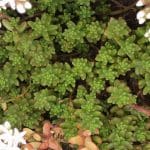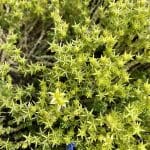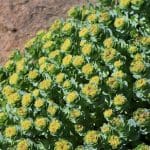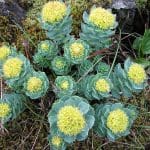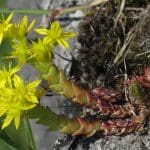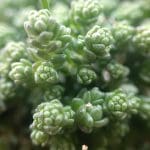Stonecrop / Spring / Sumer / Autumn / Edible
Sedum is a large genus of flowering plants in the family Crassulaceae, members of which are commonly known as Stonecrop. The genus contains 400-500 species and the leaves of most are edible. About 54 species are native to Europe but here I will concentrate on the six species most commonly used in the UK.
Common and Botanical Names
Crassulaceae/ Sedum family
1. Rosesroot: Sedum rosea
2. Reflexed Stonecrop, Sedum rupestre
3. Biting Stonecrop/Wall-pepper, Sedum acre
4. White Stonecrop, Sedum album
5. Orpine/Midsummer men, Sedum telephium
6. Wall-Pennywort/Coolers/Navelwort, Umbilicus rupestris
Scientific Classification
Kingdom – Plantae
Order – Saxifragales
Family – Crassulaceae
Genus – Sedum
Physical Charecteristics of Stonecrop
1. Roseroot, Sedum rosea
Erect, glabrous (hairless), glaucous (bluish-grey, such as on the waxy bloom of a plum or sloe) perennial up to 30cm tall. Several stems. Leaves flat, 1-4cm, alternate, dense, increasing in size up the stem. Flowers dioecious, 4 petals, greenish yellow.
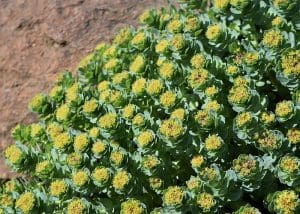
2. Reflexed Stonecrop, Sedum rupestre
Robust, glabrous, evergreen, mat-forming perennial, up to 30cm. Leaves alternate, linear and rounded in section, evenly spaced, 10-20mm. Flowers yellow, 12mm across in umbel-like inflorescence, 6-8 petals.
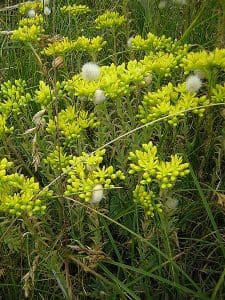
3. Biting Stonecrop/Wall-pepper, Sedum acre
Glabrous, mat-forming, evergreen perennial, up to 10cm. Leaves alternate, overlapping, broadest near base, rounded in section, 3-5m. Flowers yellow, 12mm across, in few-flowered inflorescence; 5 petals, 6-8mm.
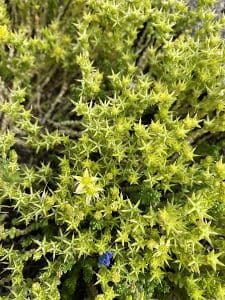
4. White Stonecrop, Sedum album,
Creeping, mat-forming, glabrous, bright green perennial, up to 15cm. Leaves alternate, 6-12mm, not clasping at base. Flowers white 6-9mm across, in dense-flowered inflorescence with several branches; scales at base of petals yellow.
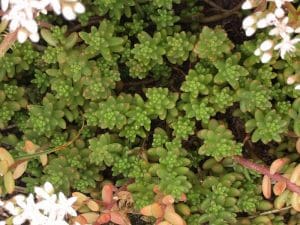
5. Orpine/Midsummer Men, Sedum telephium
Erect, glabrous, slightly glaucous perennial up to 60cm, with carrot shaped root tubers. Leaves flat, 2-8cm, alternate, numerous. Flowers red, 5 petals, 3-5mm.
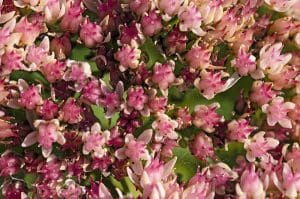
6. Wall-Pennywort/Coolers/Navelwort, Umbilicus rupestris
Erect, glabrous, unbranched perennial up to 40cm. Leaves 1.5-7cm across, mostly basal, stalked, circular, peltate (attached to the petiole (the stalk that joins a leaf to a stem) by its lower surface rather than its margin). Flowers straw coloured, drooping 8-10mm, tubular in many-flowered spike; 5 petals; 10 stamens.
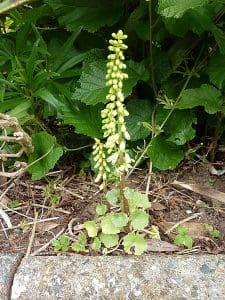
Habitat & Distribution
1. Roseroot, Sedum rosea
Found in rock crevices and ledges on coastal cliffs and mountains, usually on base-rich soils. Sea cliffs up to 1160m in West and North upland Britain.
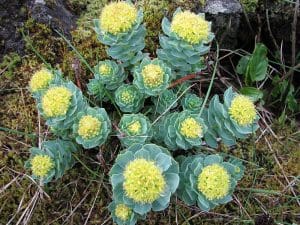
2. Reflexed Stonecrop, Sedum rupestre
Old walls, stony paths and rocky outcrops. Mostly lowland. In England, south of a line from Morcombe Bay to Kingston-upon-Hull. Introduced. Widely cultivated and naturalised throughout the British Isles, especially England and Wales.
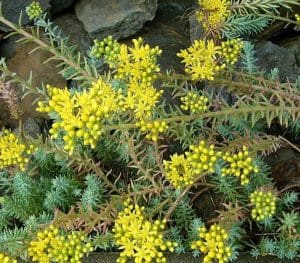
3. Biting Stonecrop/Wall-pepper, Sedum acre
Sand dunes, shingle beaches, cliff tops, heaths, walls, motorway reservations, dry open grassland. Throughout British Isles but scarce in North Scotland.
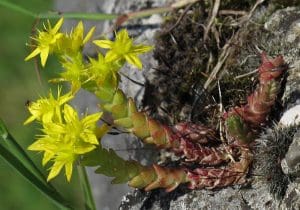
4. White Stonecrop, Sedum album
Rocks and old walls, shingle, churchyards. Throughout British Isles up to 570m but not Northern Scotland.
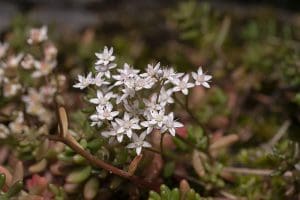
5. Orpine/Midsummer men, Sedum telephium
Hedge-banks, lane-sides, woodland clearings, field borders, limestone pavement. Throughout British Isles except Northern Scotland.
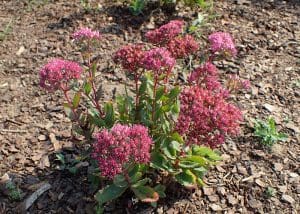
6. Wall-Pennywort/Coolers/Navelwort, Umbilicus rupestris
Cliffs, rock crevices, walls, dry sandy hedge-banks. Common in western British Isles up to 550m.
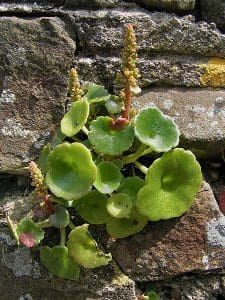
Known Hazards
Toxicity has been reported from excess consumption of other Sedum species as well as irritation from excess handling.
Could be Confused with
Sedum rubrotinctum – the Jelly Bean plant, which is not native to the UK, is poisonous and may cause irritation when ingested or touched.
Edible Uses
1. Roseroot, Sedum rosea
Stems and leaves are used by Canadian Inuit as vegetables. Native American Indians preserved the leaves by lacto-fementation. Their succulent texture makes them a good addition to a stir-fry. Roots were eaten by Inupiaq and St Lawrence Island Eskimos after harvesting them in early spring.
2. Reflexed Stonecrop, Sedum rupestre
Pickle; after soaking in salty water for 24 hours, place in a clean pan with a handful of salt; cover with vinegar, a little brown sugar and a few spices, eg, mustard seeds, ground cloves and turmeric. Cover the pan and heat it over a low heat. Take it off the heat before it becomes soft.
3. Biting Stonecrop/Wall-pepper, Sedum acre
Acrid, peppery flavour; quite tart. Taking a bite in isolation the pepperiness is overpowering; mixing it with other salad ingredients tempers this effect. Dry and use as a peppery seasoning.
4. White Stonecrop, Sedum album
The leaves are tart and succulent with a sharp tang and slight bitterness, like tiny lemony pea pods. They should either be used raw or after brief cooking. Cooking turns them brighter green.
5. Orpine/Midsummer Men, Sedum telephium
Leaves are an excellent wild salad ingredient with a slightly tart flavour and a marvelous succulent texture. Use young leaves in salad; young and old leaves boiled briefly or friend.
6. Wall-Pennywort/Coolers/Navelwort, Umbilicus rupestris
Among the most interesting looking leaves you can put on your plate. Quite thick with a succulent texture, the flavour is mild, a little like mangetout. Use as salad, as a green vegetable dressed with a little oil and seasoned, an interesting garnish, or lightly pan fry.
Notes on Herbal uses
Navelwort (Wall-Pennywort/Coolers): The name Navelwort because the stalk grows from the centre of the leaf, forming a dimple on top. The name Coolers probably derives from the use of the sappy leaves as an ointment for burns.
Extra notes from the Foragers
Roseroot: The root when cut develops a strong scent of roses and it was grown in cottage gardens to make scented waters.
Biting Stonecrop/Wall-pepper/Welcome-home-husband-though-never-so-drunk: This will naturally grow on roofs.
Orpine has been used as a divinatory plant. The name Midsummer Men referred to custom widespread on Midsummer’s Eve, in which young men and women would stick slips of Orpine in cracks in house beams and joists. The cuttings were placed in pairs to represent two sweethearts; the way in which they inclined towards or away from each other was believed to predict the likely progress of a romance.
Crassulaceae derives from the Latin Crassus, meaning thick; the plants grow in thick patches and most species have thick, succulent leaves, enabling them to withstand intense heat. This characteristic is useful in architecture where they can be used to provide a roof covering to minimise the heat absorption of buildings. The Rolls Royce Motor Cars plant in Goodwood, England, has a 242,000 square feet roof complex covered in Sedum. Planting Sedum between rails of tramways is used as a low maintenance alternative to grass in Berlin, Le Mans and Warsaw. This provides a permeable surface for water management, noise reduction and beautification.



